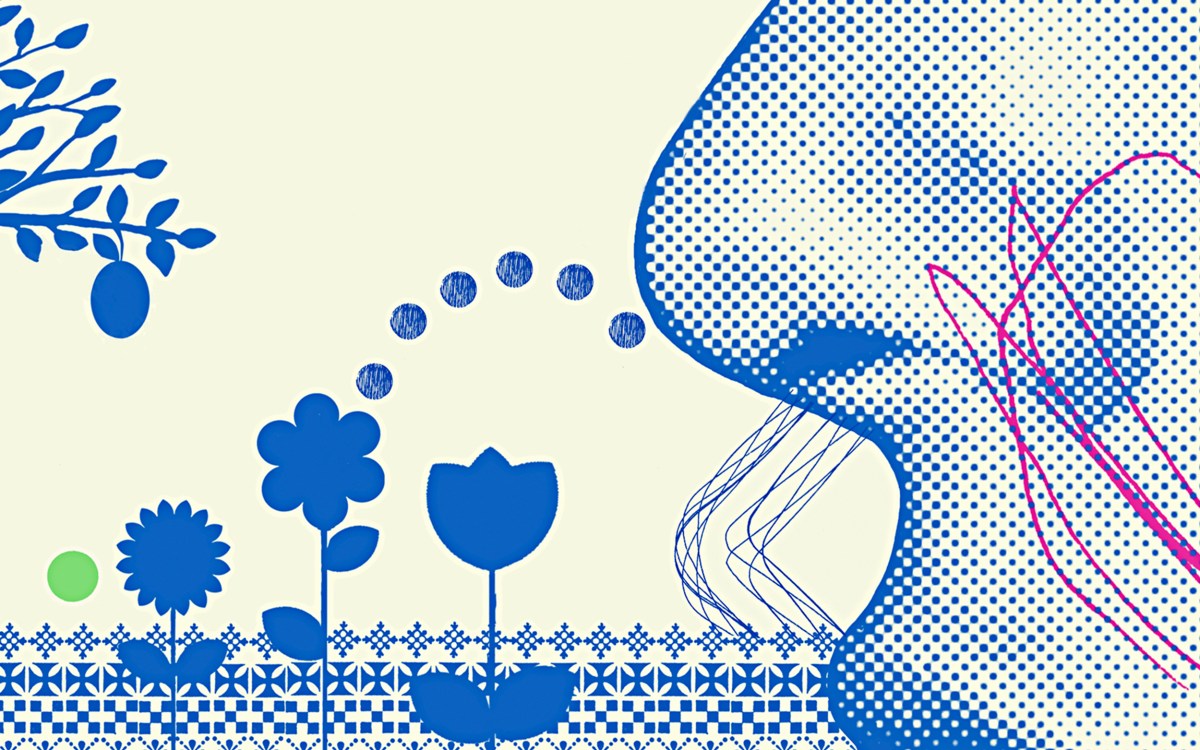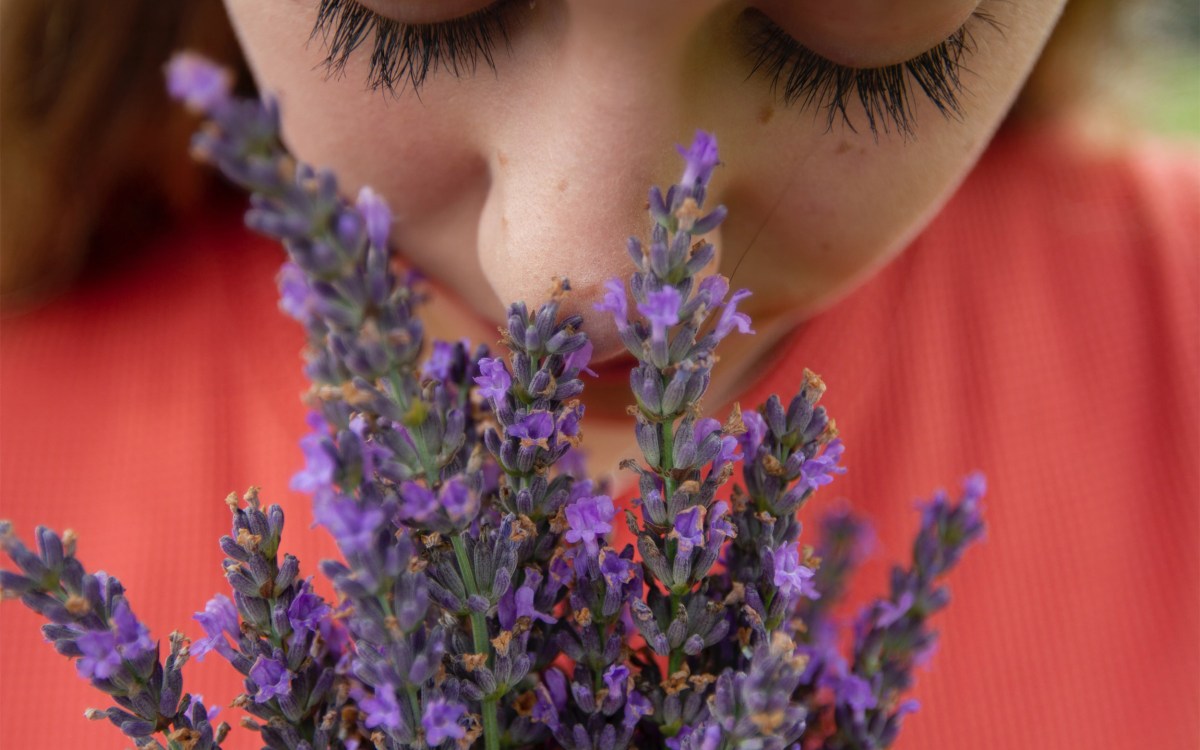
Illustration by Cath Riley/Ikon Images
What Harold McGee learned after decade of sniffing durian, keyboards, outer space
In book talk, James Beard Award-winning author explains why galaxy might be partly redolent of cooked eggs, what smells can tell us about our world
Everyone knows cheese can smell like stinky feet. But did you know parmesan can smell like pineapple, green teas carry a whiff of seashore, and Belgian beers share an aroma with Band-Aids and horse stables?
“Smell is a really interesting sense, maybe the most interesting sense, because it’s our most intimate and direct contact with the outside world,” said Harold McGee, author of the book “Nose Dive: A Field Guide to the World’s Smells.”
McGee, who has spent decades writing about the science of food and cooking, joined David Weitz, the Mallinckrodt Professor of Physics and of Applied Physics at Harvard, for a virtual Harvard Science Book Talk last week, presented by the University’s Division of Science, Cabot Science Library, and Harvard Book Store. McGee and Weitz have lectured together for 13 years as part of Harvard’s Science and Cooking Lecture Series. But this time, the duo discussed smells that waft way beyond the kitchen — or what McGee dubs the “osmocosm,” the vast universe of scents perfuming swamps, Scottish peat, outer space, oceans, and humans, too.
Smell, McGee said, “gives us such access to the things around us — invisible, inaudible — but we still know something about the world through this particular sense.”
About a decade ago, McGee set out to write a book — not about smell, but about flavor. Back in the 1970s, when McGee was finishing his Ph.D. thesis on “Keats and the Progress of Taste” at Yale, scientists knew little about how flavor worked. Then, in the early 2000s, researchers discovered human olfactory and taste receptors — proteins that bind to particles in food and drink and relay information about those substances to our brains.
“It was time to write a book about flavor,” McGee said. “And that was my initial intention.”
Flavor is essentially taste plus smell, McGee said. But as the self-designated “Curious Cook” (the name of McGee’s old New York Times science and food column) started investigating flavors, he realized that even though the human tongue can register about a dozen different tastes, the nose can take in hundreds of smells. “It’s with smell that we get the tremendous diversity of flavors,” McGee said.
“Smell is a really interesting sense, maybe the most interesting sense, because it’s our most intimate and direct contact with the outside world.”
So, McGee set off to explore the osmocosm, discovering that aromas are complex combinations of molecules. The smell humans register as “apple,” for example, is a whole host of molecules small enough to detach from an apple, float through the air, and shimmy up a nostril. Once inside, smell receptors grab onto those molecules to perform some chemical detective work before releasing them back into the world.
But why? McGee wanted to know. And what does that molecular detective work tell us about the nature of the thing we’re smelling? To find an answer, he went all the way back to the Big Bang and the Earth’s first primordial smells, many of which are now floating around in outer space. Radio telescopes, McGee said, can sense these molecules, which include esters (fragrant compounds that can sometimes smell like raspberries), hydrogen sulfide (cooked eggs or decaying vegetation), and ozone (the air after a lightning storm).
Next, McGee examined the explosion of scents that came with life on Earth, including microbes, fungi, plants, and, eventually, animals. “Of them all, by far the best are the plants,” McGee said. These exploit volatile molecules — the bits that can break free of their origins and fly to noses — to repel predators, attract pollinators, and communicate with fellow plants.
Today, humans exploit these molecules, too. But, unlike plants, we often manipulate smells for pleasure, not protection, crafting recipes, perfumes, and incense to titillate our noses. In Japan, McGee said, there’s a practice called The Way of Incense, also known as listening to incense, in which people try to experience the fragrance beyond the nose — akin to mindfully focusing on a sound rather than simply hearing it.
McGee did explain why seemingly disparate elements, like parmesan and pineapple or oysters and cucumbers, can share undertones: Because smells are complex combinations of molecules, some pop up in multiple formulas. But, he said, there’s still much we don’t know about, for example, why scents provoke certain reactions in humans — reactions that can vary from intense pleasure to nausea depending on which human gets a whiff.
In the past, smells might have been more useful, enabling early humans to detect a lion hiding in the grass, for example, but modern humans tend to associate smells with childhood, travel, and family, McGee said. Other animals have their own olfactory universes, which they often use to identify snacks and threats in their surroundings. (Of course, human nostrils can still detect dangers, like smoke, gas leaks, or rotten food.)
Near the end of the talk, Weitz asked McGee whether the human osmocosm is fixed or could be expanding. “Are there smells that we’ve never smelled before?” he asked.
With artificial intelligence, McGee said, scientists can now build molecules that do not yet exist in nature. Computers can even deduce what they might smell like. So, yes, McGee said, “I think the osmocosm will grow.”







